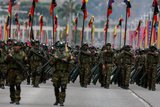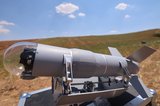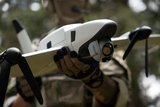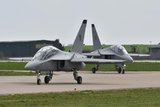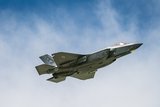General Atomics completes test of small UAS aerial recovery system
A towline being deployed from a GA-ASI MQ-20 Avenger UAS over Dugway Proving Ground, Utah. (Photo: General Atomics)
The towline for last month’s test was deployed from a General Atomics Aeronautical Systems (GA-ASI) MQ-20 Avenger UAS over Dugway Proving Ground, Utah.
The aerial recovery concept utilises a towline and smart end feature, which serves as a beacon and mechanical interface for aerial recovery.
The SUAS/ALE calculates its precise position relative to the smart end feature for navigation into towline intercept, followed by a manoeuvre to capture the end feature.
Related Articles
General Atomics achieves AI flight milestone with Avenger UAV
Once secure on the towline, the SUAS/ALE folds its wings and stops its engine to transition into a passively stable towed body. A podded hoist aboard the capital ship reels in the SUAS/ALE to a captive carriage state where the two platforms return to base together.
During this demonstration, a hoist from Breeze-Eastern equipped with GA-ASI’s smart end feature was integrated into Avenger’s payload bay. While in flight, the towline was deployed away from Avenger to the optimal distance for aerial recovery.
The smart end feature was able to wirelessly transmit its position back to Avenger, confirming its ability to transmit the data to a nearby SUAS/ALE for aerial recovery. The smart end feature’s deployed position correlated to GA-ASI’s multi-degree-of-freedom finite element catenary models, confirming its potential for SUAS/ALE aerial recovery.
Beyond just captive carry back to base, the SUAS/ALE can be refuelled, recharged, and/or rearmed and then redeployed. Redeployment can occur from the host aircraft, enabling SUAS/ALEs to conduct their own orbits from airborne launch and recovery positions.
Aerial redeployment allows UAS like GA-ASI’s Avenger or MQ-9A Reaper to serve as mobile command centers for a network of SUAS/ALEs in a persistent, expansive grid for surveillance, electronic attack, enemy air defence suppression, communication pathways, or joint all-domain mobile command and control for days or weeks at a time.
More from Air Warfare
-
![Spain moves ahead with transport, intelligence and training aircraft modernisation efforts]()
Spain moves ahead with transport, intelligence and training aircraft modernisation efforts
Confirming its C295 order in late December, the Spanish Ministry of Defence also awarded Airbus with its Hurjet procurement contract and both Airbus and Indra with a contract to investigate a proposed Signals Intelligence aircraft solution by 2028.
-
![December Drone Digest: Germany, Australia and US champion indigenous UAV production]()
December Drone Digest: Germany, Australia and US champion indigenous UAV production
One of the key trends seen in December has been the rise in indigenous investment within the UAV market, particularly across certain countries, with Germany, Australia and the US focusing on their commitments to sovereign development.
-
![What might next-generation military aircrew training look like?]()
What might next-generation military aircrew training look like?
Changing roles for combat aircraft fleets, the rise of simulation and LVC technologies, and the increasing cost of flight hours could all be leading to a paradigm shift in military pilot training.
-
![2025 air market review: European defence independence, next-gen tech and export concerns dominate]()
2025 air market review: European defence independence, next-gen tech and export concerns dominate
This year’s (geo)political turmoil has challenged many long-prevailing assumptions, leading to far-reaching consequences for air forces and their supplier bases in industry worldwide – with five key trends in review for 2025.
-
![Poland air report: Drones, transport aircraft and tankers dominate potential procurement plans]()
Poland air report: Drones, transport aircraft and tankers dominate potential procurement plans
With a rising defence budget and equipment list, Poland’s air market is set to grow as the country continues to modernise its transport and helicopter fleets while seeking out uncrewed aerial vehicles and loitering munitions.
-
![Portugal signals interest in establishing A-29N final assembly line]()
Portugal signals interest in establishing A-29N final assembly line
As the launch customer for the NATO-configured variant, Portugal also took delivery of the first five A-29N aircraft from its order for 12, placed in 2024.










